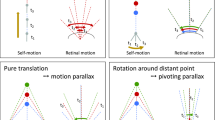Abstract
The orientation sensitivity of the visual movement detection system relative to the axes of the eye was investigated for the landing response by changing the direction of movement of a periodic striped pattern (unidirectional movement) and a “two-stripe pattern” consiting of two stripes moving apart (bidirectional movement). In the momocular, equatorial regions of the eye progressive motion proves to be most effective, whereas in the frontal (equational), binocular region descendive motion is most effective in eliciting the landing response, probably caused by binocular interactions. A strong enhancement of the response is induced by stimulation in the binocular region of the two eyes. The orientation of elementary movement detectors relative to the axes of the ommatidial array is discussed. The findings are summarized in a functional model of the landing response.
Similar content being viewed by others
References
Beersma, D.G.M., Stavenga, D.G., Kuiper, J.W.: Organization of visual axes in the compound eye of the fly Musca domestica L. and behavioural consequences. J. Comp. Physiol. 102, 305–320 (1975)
Bishop, L.G., Keehn, D.G., McCann, G.D.: Motion detection by interneurons of optic lobes and brain of the flies Calliphora phaenicia and Musca domestica. J. Neurophysiol. 31, 509–525 (1968)
Braitenberg, V.: Patterns of projections in the visual system of the fly. I. Retina-lamina projections. Exp. Brain Res. 3, 271–298 (1967)
Braitenberg, V., Taddei-Ferretti, C.: Landing reaction of Musca domestica. Naturwissenschaften 53, 155–156 (1966)
Dvorak, D.R., Bishop, L.G., Eckert, H.E.: On the identification of movement detectors in the fly optic lobe. J. Comp. Physiol 100, 5–23 (1975)
Eckert, H.: Identifizierte, bewegungssensitive Interneurone als neurophysiologische Korrelate füt das Bewegungssehen der Insekten. Verh. Dtsch. Zool. Ges., Hamburg 1976. Stuttgart, New York: Gustav Fischer 1976
Eckert, H.: Identification of horizontal and vertical movement detection systems in insects. Abstract: Meeting of the Society for Neuroscience, Los Angeles, California, USA, 1977
Eckert, H.: Response properties of dipteran giant visual interneurones involved in control of optomotor behaviour. Nature (London) 271, 358–360 (1978)
Eckert, H.: Anatomie, Elektrophysiologie und funtionelle Bedeutung bewegungssensitiver Neurone in der Sehbahn von Dipteren. Habilitationsschrift, Bochum 1979
Eckert, H.: Functional properties of the H1-neurone in the third optic ganglion of the blowfly, Phaenicial. J. Comp. Physiol. 135, 29–39 (1980)
Eckert, H., Bishop, L.G.: Anatomical and physiological properties of the “vertical cells” in the fly, Phaenicia sericata (Calliphoridae, Diptera). J. Comp. Physiol. 126, 57–86 (1978)
Eckert, H., Franceschini, N.: Gradient of optical resolution across the compound eye of the blowfly, Phaenicia sericata. Manuscript (1979)
Eckert, H., Hamdorf, K.: The interaction of excitation and inhibition in the landing response of the blowfly, Calliphora: a behavioural study. J. Comp. Physiol. (in press) (1980a)
Eckert, Hamdorf, K.: The contrast frequency dependence: a criterion for judging the participation of neurones in the control of behavioural responses. Science (submited for publication) (1980b)
Eckert, H., Fligge, B., Hamdorf, K.: Excitation and inhibition in the activation of the landing response of the blowfly, Calliphora. Naturwissenschaften 66, 368 (1979)
Fermi, G., Reichardt, W.: Optomotorische Reaktionen der Fliege Musca domestica. Kybernetik 2 15–28 (1963)
Fligge, B.: Neue Experimente zur Landereaktion bei Fliegen. Staatsexamensarbeit, Ruhr-Universität Bochum 1978
Goodman, L.J.: The landing responses of insects. I. The landing response of the fly, Lucilia sericata, and other Calliphorinae. J. Exp. Biol. 37, 854–878 (1960)
Goodman, L.J.: The landing responses of insects. II. The electrical response of the compound eye of the fly, Lucilia sericata. J. Exp. Biol. 41, 403–415 (1964)
Hamdorf, K.: In: Praktikum der Zoophysiologie. Hanke, W., Hamdorf, K., Horn, E., Schlieper, C. (eds.) Stuttgart, New York: Gustav Fischer 1976
Hausen, K.: Functional characterization and anatomical identification of motion sensitive neurons in the lobula plate of the blowfly, Calliphora erythrocephala. Z. Naturforsch., Teil C, 31, 629–633 (1976a)
Hausen, K.: Struktur, Funktion und Konnektivität bewegungsempfindlicher Interneurone im dritten optischen Neuropil der Schmeißfliege Calliphora erythrocephala. Inauguraldissertation, Tübingen 1976b
Hausen, K.: Signal processing in the insect eye. In: Function and formation of neural systems. Stent, G.S. (ed.), pp. 81–110. Berlin: Dahlem Konferenzen (1977)
Heisenberg, M., Buchner, E.: The rôle of retinula cell types in visual behaviour of Drosophila melanogaster. J. Comp. Physiol. 117, 127–162 (1977)
Hengstenberg, R.: Spike responses of “non-spiking” visual interneurones. Nature (London) 270, 338–340 (1977)
Kirschfeld, K.: The visual system of the fly: physiological optics and functional anatomy as related to behaviour. In: The neurosciences fourth study program. Schmitt, F.O. (ed.), Cambridge, MA: MIT Press 1979
Perez de Talens, A.F., Taddei-Ferretti, C.: Landing reaction of Musca domestica. Dependence on dimensions and position of the stimulus. J. Exp. Biol. 52, 233–256 (1970)
Poggio, T., Reichardt, W.: Visual control of orientation behaviour. II. Towards the underlying neural interactions. Q. Rev. Biophys. 9, 377–438 (1976)
Reichardt, W., Poggio, T.: Visual control of orientation behaviour. I. A quantitative analysis. Q. Rev. Biophys. 9, 311–375 (1976)
Taddei-Ferretti, C., Perez de Talens, A.F.: Landing reaction of Musca domestica. III. Dependence on the luminous characteristics of the stimulus. Z. Naturforsch., Teil C, 28, 568–578 (1973a)
Taddei-Ferretti, C., Perez de Talens, A.F.: Landing reaction of Musca domestica. IV. A: Monocular and binocular vision; B: Relationship between landing and optomotor reaction. Z. Naturforsch., Teil C, 28, 579–592 (1973b)
Author information
Authors and Affiliations
Rights and permissions
About this article
Cite this article
Eckert, H. Orientation sensitivity of the visual movement detection system activating the landing response of the blowflies, Calliphora, and Phaenicia: A behavioural investigation. Biol. Cybernetics 37, 235–247 (1980). https://doi.org/10.1007/BF00337042
Received:
Issue Date:
DOI: https://doi.org/10.1007/BF00337042




